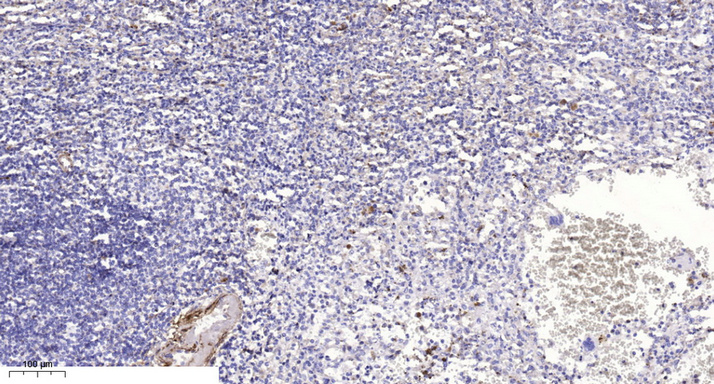KLF13 (Acetyl Lys166) rabbit pAb
- Catalog No.:YK0152
- Applications:WB;IHC
- Reactivity:Human;Mouse
- Target:
- KLF13
- Gene Name:
- KLF13 BTEB3 NSLP1
- Protein Name:
- KLF13 (Acetyl Lys166)
- Human Gene Id:
- 51621
- Human Swiss Prot No:
- Q9Y2Y9
- Mouse Gene Id:
- 50794
- Mouse Swiss Prot No:
- Q9JJZ6
- Immunogen:
- Synthesized peptide derived from human KLF13 (Acetyl Lys166)
- Specificity:
- This antibody detects endogenous levels of Human,Mouse KLF13 (Acetyl Lys166)
- Formulation:
- Liquid in PBS containing 50% glycerol, 0.5% BSA and 0.02% sodium azide.
- Source:
- Polyclonal, Rabbit,IgG
- Dilution:
- WB 1:500-2000;IHC 1:50-300
- Purification:
- The antibody was affinity-purified from rabbit serum by affinity-chromatography using specific immunogen.
- Concentration:
- 1 mg/ml
- Storage Stability:
- -15°C to -25°C/1 year(Do not lower than -25°C)
- Other Name:
- Krueppel-like factor 13 (Basic transcription element-binding protein 3;BTE-binding protein 3;Novel Sp1-like zinc finger transcription factor 1;RANTES factor of late activated T-lymphocytes 1;RFLAT-1;Transcription factor BTEB3;Transcription factor NSLP1)
- Observed Band(KD):
- 32kD
- Background:
- KLF13 belongs to a family of transcription factors that contain 3 classical zinc finger DNA-binding domains consisting of a zinc atom tetrahedrally coordinated by 2 cysteines and 2 histidines (C2H2 motif). These transcription factors bind to GC-rich sequences and related GT and CACCC boxes (Scohy et al., 2000 [PubMed 11087666]).[supplied by OMIM, Mar 2008],
- Function:
- domain:The Ala/Pro-rich domain may contain discrete activation and repression subdomains and also can mediate protein-protein interactions.,function:Represses transcription by binding to the BTE site, a GC-rich DNA element, in competition with the activator SP1. It also represses transcription by interacting with the corepressor Sin3A and HDAC1. Activates RANTES expression in T-cells.,PTM:Phosphorylated.,similarity:Belongs to the Sp1 C2H2-type zinc-finger protein family.,similarity:Contains 3 C2H2-type zinc fingers.,tissue specificity:Ubiquitous.,
- Subcellular Location:
- Nucleus.
- Expression:
- Ubiquitous.
- June 19-2018
- WESTERN IMMUNOBLOTTING PROTOCOL
- June 19-2018
- IMMUNOHISTOCHEMISTRY-PARAFFIN PROTOCOL
- June 19-2018
- IMMUNOFLUORESCENCE PROTOCOL
- September 08-2020
- FLOW-CYTOMEYRT-PROTOCOL
- May 20-2022
- Cell-Based ELISA│解您多样本WB检测之困扰
- July 13-2018
- CELL-BASED-ELISA-PROTOCOL-FOR-ACETYL-PROTEIN
- July 13-2018
- CELL-BASED-ELISA-PROTOCOL-FOR-PHOSPHO-PROTEIN
- July 13-2018
- Antibody-FAQs
- Products Images

- Immunohistochemical analysis of paraffin-embedded human spleen. 1, Antibody was diluted at 1:200(4° overnight). 2, Tris-EDTA,pH9.0 was used for antigen retrieval. 3,Secondary antibody was diluted at 1:200(room temperature, 45min).


